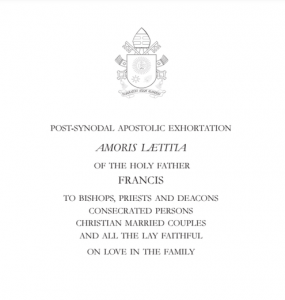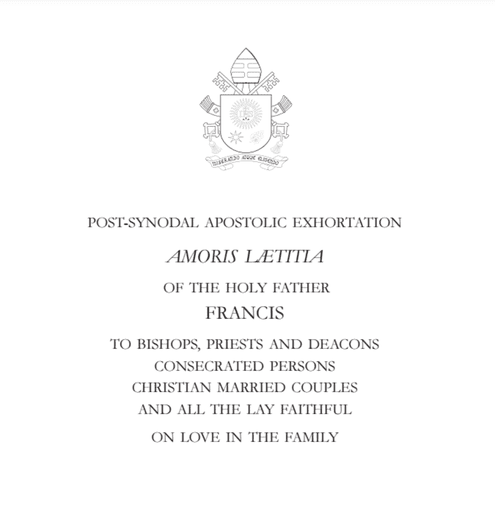Pope Francis’ post-synodal apostolic exhortation Amoris Laetitia (“On Love in the Family”) was promulgated March 19, 2016, the Solemnity of St. Joseph the Workman. The letter  caps recent years of reflection on the family, beginning with the October 2014 Extraordinary General Assembly of the Synod of Bishops, followed by the September 2015 World Meeting of Families in Philadelphia, and concluding with the October 2015 Ordinary General Assembly of the Synod of Bishops. This latter synod sent to the Holy Father its own final report, which included an invitation to issue “a document on the family, so that the family, the domestic Church, might increasingly radiate Christ, who is the light of the world.”
caps recent years of reflection on the family, beginning with the October 2014 Extraordinary General Assembly of the Synod of Bishops, followed by the September 2015 World Meeting of Families in Philadelphia, and concluding with the October 2015 Ordinary General Assembly of the Synod of Bishops. This latter synod sent to the Holy Father its own final report, which included an invitation to issue “a document on the family, so that the family, the domestic Church, might increasingly radiate Christ, who is the light of the world.”
Amoris Laetitia was released to the public on Friday, April 8, and since then there has been no lack of coverage, confusion, and opinion on all sides, particularly concerning the question of communion to those in “various situations of weakness or imperfection”. (296) But in addition to this question, the Holy Father, like the Synod itself, comments on the liturgical rite of marriage.
Concerning the ministers of the Rite, the Holy Father reiterates the Church’s tradition: “In the Church’s Latin tradition, the ministers of the sacrament of marriage are the man and the woman who marry [Cf. Pius XII, Encyclical Letter Mystici Corporis Christi (29 June 1943): AAS 35 (1943), 202: “Matrimonio enim quo coniuges sibi invicem sunt ministri gratiae …”]; by manifesting their consent and expressing it physically, they receive a great gift. Their consent and their bodily union are the divinely appointed means whereby they become ‘one flesh.’ By their baptismal consecration, they were enabled to join in marriage as the Lord’s ministers and thus to respond to God’s call. Hence, when two non-Christian spouses receive baptism, they need not renew their marriage vows; they need simply not reject them, since by the reception of baptism their union automatically becomes sacramental. Canon Law also recognizes the validity of certain unions celebrated without the presence of an ordained minister [Cf. Code of Canon Law, cc. 1116; 1161-1165; Code of Canons of the Eastern Churches, 832; 848-852]. The natural order has been so imbued with the redemptive grace of Jesus that ‘a valid matrimonial contract cannot exist between the baptized without it being by that fact a sacrament” [Ibid., c. 1055 §2]. The Church can require that the wedding be celebrated publicly, with the presence of witnesses and other conditions that have varied over the course of time, but this does not detract from the fact that the couple who marry are the ministers of the sacrament. Nor does it affect the centrality of the consent given by the man and the woman, which of itself establishes the sacramental bond. This having been said, there is a need for further reflection on God’s action in the marriage rite; this is clearly manifested in the Oriental Churches through the importance of the blessing that the couple receive as a sign of the gift of the Spirit. (75)
On the prayerful preparation for the liturgical celebration, the Holy Father says: “The couple can also meditate on the biblical readings and the meaningfulness of the rings they will exchange and the other signs that are part of the rite. Nor would it be good for them to arrive at the wedding without ever having prayed together, one for the other, to seek God’s help in remaining faithful and generous, to ask the Lord together what he wants of them, and to consecrate their love before an image of the Virgin Mary. Those who help prepare them for marriage should help them experience these moments of prayer that can prove so beneficial. ‘The marriage liturgy is a unique event, which is both a family and a community celebration. The first signs of Jesus were performed at the wedding feast of Cana. The good wine, resulting from the Lord’s miracle that brought joy to the beginning of a new family, is the new wine of Christ’s covenant with the men and women of every age…. Frequently, the celebrant speaks to a congregation that includes people who seldom participate in the life of the Church, or who are members of other Christian denominations or religious communities. The occasion thus provides a valuable opportunity to proclaim the Gospel of Christ’” [Relatio Finalis 2015, 59]. (216)
The above excerpts and, indeed, the entire letter are an impetus to understand fully and celebrate faithfully the Marriage Rite, recently published in its second edition.


